Thanks Brian, I am glad you like it.Steve, this is an exceptionally well done model and build log.
Cheers,
Stephen.
 |
As a way to introduce our brass coins to the community, we will raffle off a free coin during the month of August. Follow link ABOVE for instructions for entering. |
 |
Thanks Brian, I am glad you like it.Steve, this is an exceptionally well done model and build log.
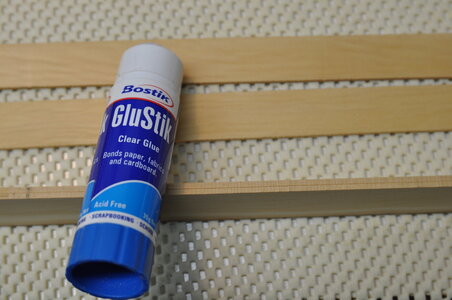
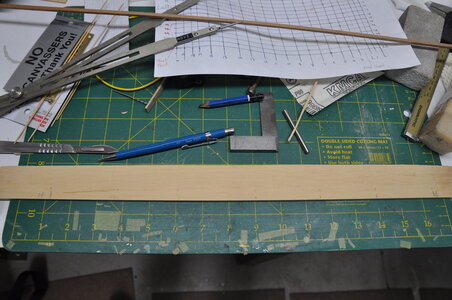
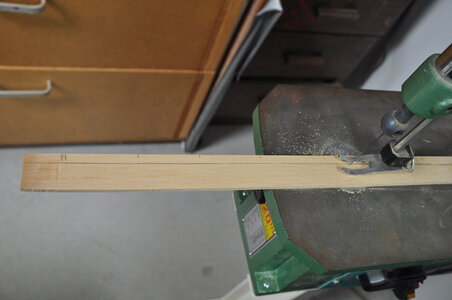
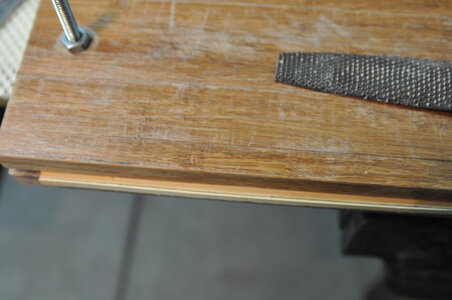
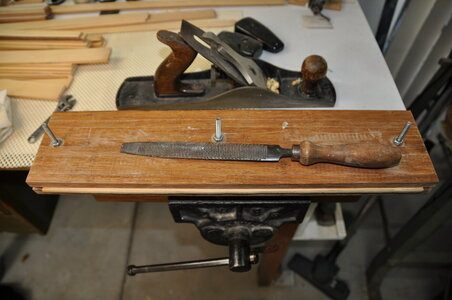
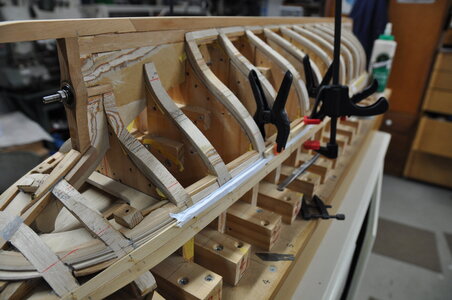
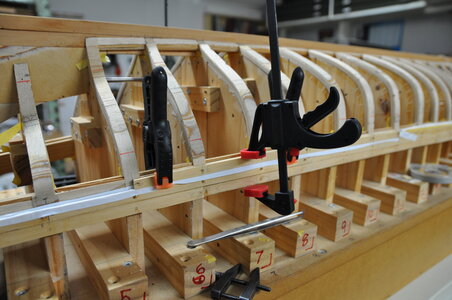
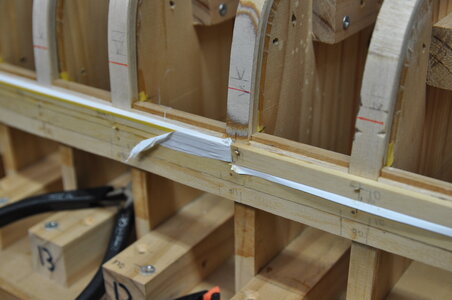
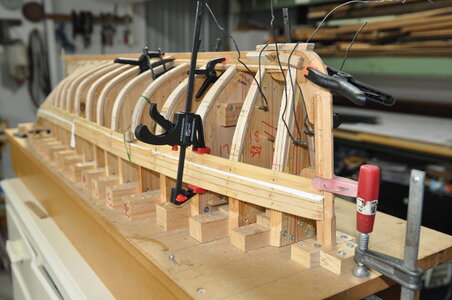
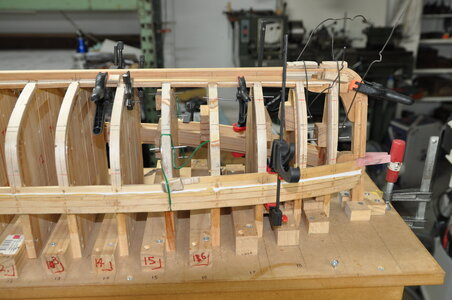
Your care for precision and patience are showing and will pay off in the final results. Well done! PT-2Part 7.
Returning to completing work on the removable section once that was done I could start on planking.
After adding some keel doublers, fairing the frame’s checking progress with a fairing batten until I was happy that my planking would sit flat on the frame’s and into the rabbet.
From Tree to Sea tells me that LT 100 had 22 strakes on each side of the hull. Following Harold Underhill’s instructions to work out the run of planks I ran 3 temporary battens starting around mid ships on the turn of the bulge on each side of the hull to divide it into 4 areas, the other two battens halving the area left.
The objective is to get these battens to sit flat on the frame doing this without bending up or down pull them around the hull so they sit nicely, a fair bit of fiddling around is required, adjusting looking from different angles until you are happy with there appearance, then walk away for a while come back and check again!
I ended up changing the run of these battens several times, ending up using a red pencil to mark the final run because there were too many pencil marks! Once these 4 areas had been marked out accurate measurements were taken along the circumference of the frames.
Two of the areas would have 6 strakes each, with the other two areas having 5 strakes. Proportional dividers were used to divide these areas to give the plank width at each frame.
Before going any farther a “butt diagram” was worked out to find where the plank ends would fall, as it turned out this was a very handy thing to have.
I made a plank holding clamp that made it easier for me to hold and trim down planks.
I also made a steaming apparatus, an old electric kettle being the steam source a length of galvanised down pipe with a “T” put into it at one end and a piece of mesh bent to form a shelf for planks to lay on while being steamed.
I intended to plank this model in a fashion similar to the real boat, for the most part I think I have achieved this.View attachment 183121View attachment 183122View attachment 183123View attachment 183124View attachment 183125View attachment 183127View attachment 183128View attachment 183129View attachment 183130
Chers,
Stephen.

Dear StephenPart 7.
Returning to completing work on the removable section once that was done I could start on planking.
After adding some keel doublers, fairing the frame’s checking progress with a fairing batten until I was happy that my planking would sit flat on the frame’s and into the rabbet.
From Tree to Sea tells me that LT 100 had 22 strakes on each side of the hull. Following Harold Underhill’s instructions to work out the run of planks I ran 3 temporary battens starting around mid ships on the turn of the bulge on each side of the hull to divide it into 4 areas, the other two battens halving the area left.
The objective is to get these battens to sit flat on the frame doing this without bending up or down pull them around the hull so they sit nicely, a fair bit of fiddling around is required, adjusting looking from different angles until you are happy with there appearance, then walk away for a while come back and check again!
I ended up changing the run of these battens several times, ending up using a red pencil to mark the final run because there were too many pencil marks! Once these 4 areas had been marked out accurate measurements were taken along the circumference of the frames.
Two of the areas would have 6 strakes each, with the other two areas having 5 strakes. Proportional dividers were used to divide these areas to give the plank width at each frame.
Before going any farther a “butt diagram” was worked out to find where the plank ends would fall, as it turned out this was a very handy thing to have.
I made a plank holding clamp that made it easier for me to hold and trim down planks.
I also made a steaming apparatus, an old electric kettle being the steam source a length of galvanised down pipe with a “T” put into it at one end and a piece of mesh bent to form a shelf for planks to lay on while being steamed.
I intended to plank this model in a fashion similar to the real boat, for the most part I think I have achieved this.View attachment 183121View attachment 183122View attachment 183123View attachment 183124View attachment 183125View attachment 183127View attachment 183128View attachment 183129View attachment 183130
Chers,
Stephen.
Hi shota70,Dear Stephen
This is a very creative invention, well done
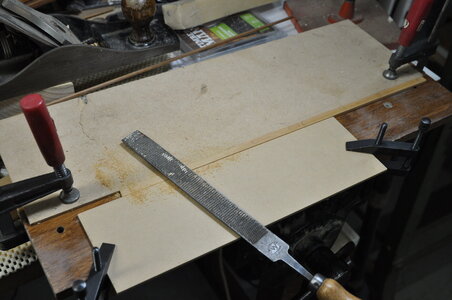
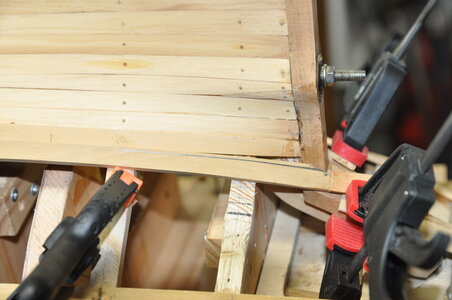
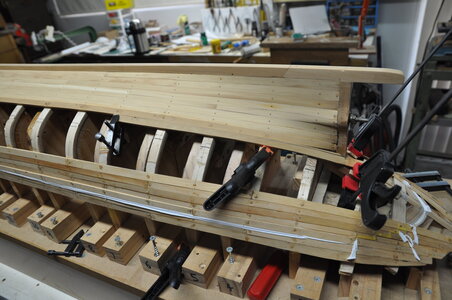
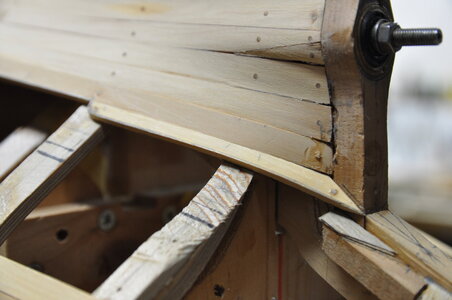
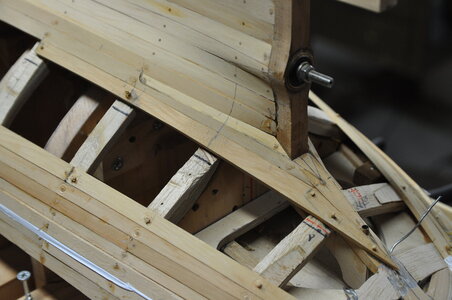
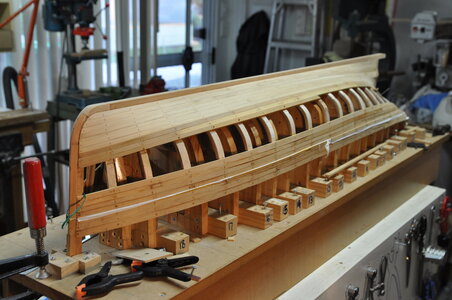
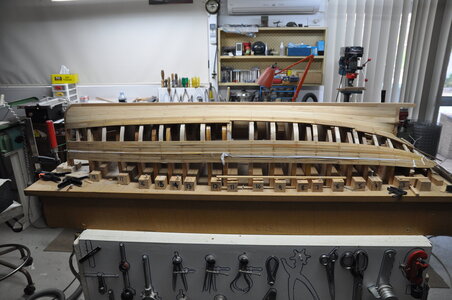
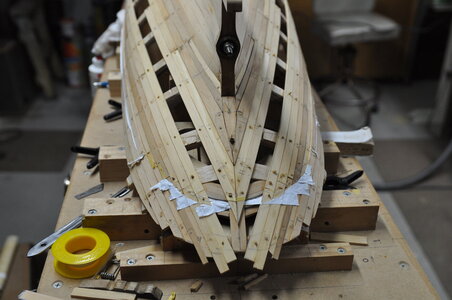
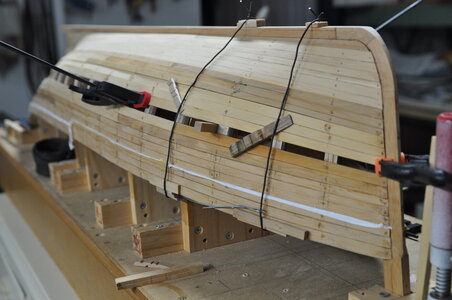
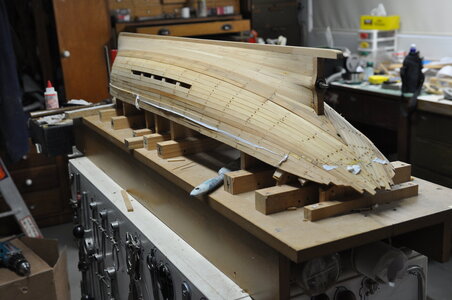
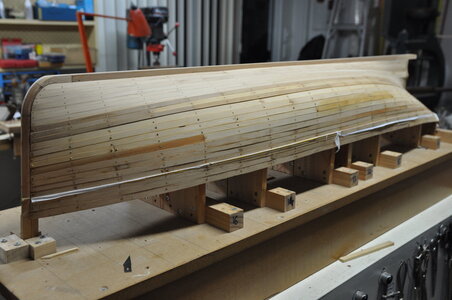

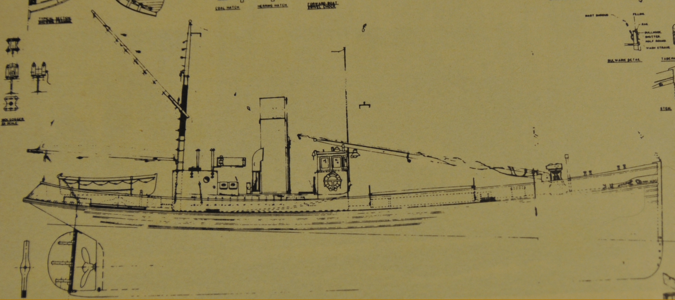
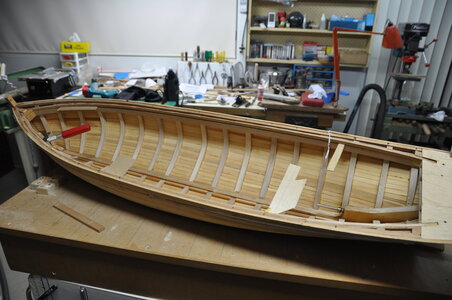
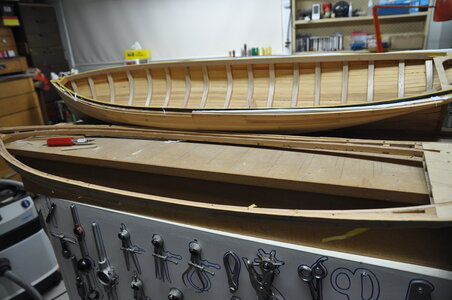
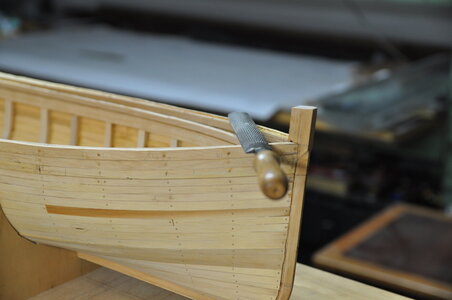
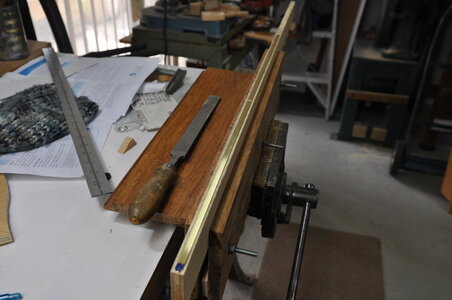
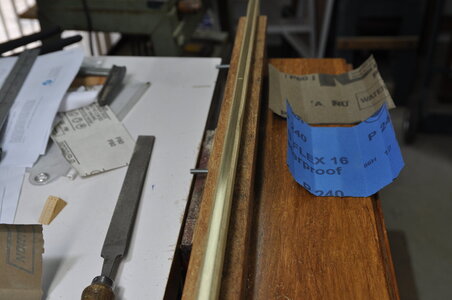
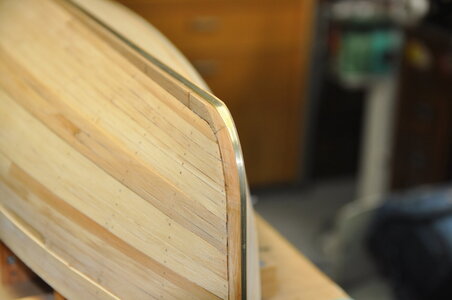
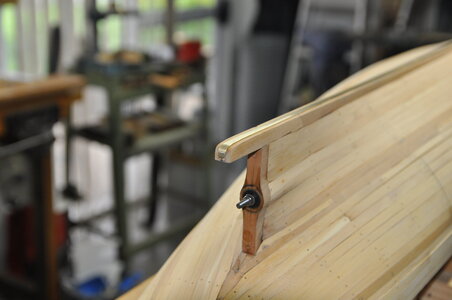
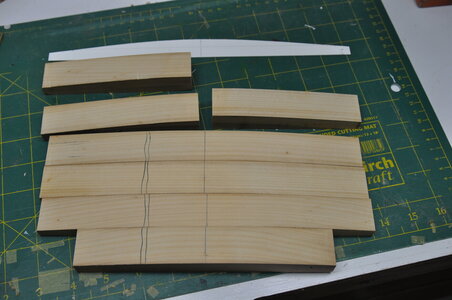
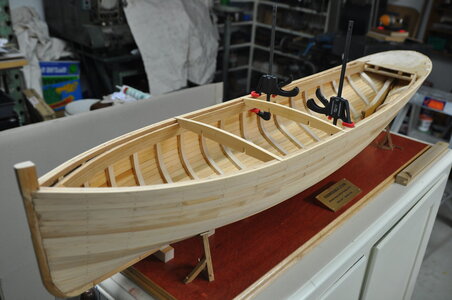
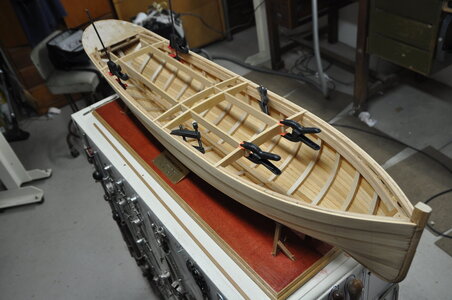
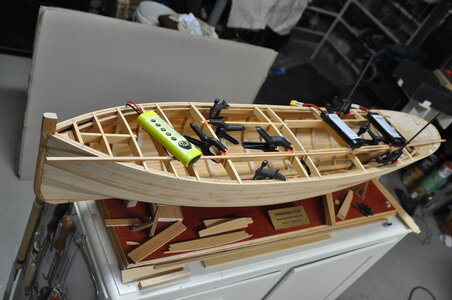
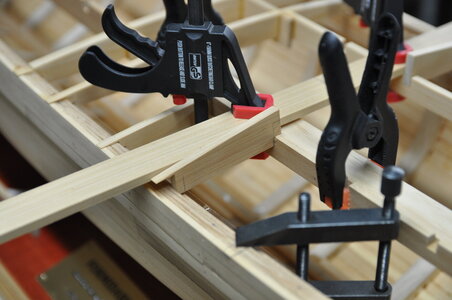
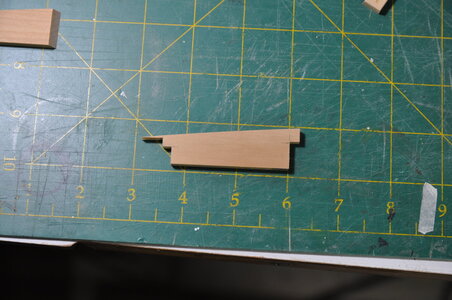
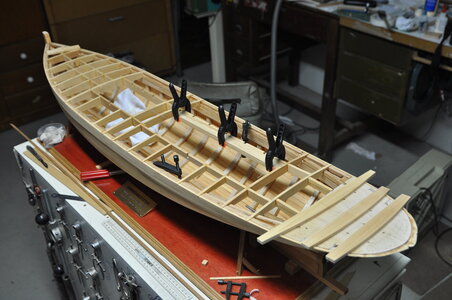

Dear StephenPart 10.
After planking had been finished came removal from the building board then removing all the former's from inside the hull, and at last time to separate the upper and lower parts of the hull (that’s if I hadn’t accidentally glued them together).
I used small wedges to force the parts apart and to my relief after some initial reluctance to move with a pop the two parts started to separate.
I continued carefully prising the two parts apart taking my time to ensure I didn’t damage anything.
I would have to say that I was very happy with my effort so far, I quite like the lines on this hull.
I used a rasp and sandpaper on a stick to carefully trim down to the sheer line.
I put the hull back on the building board temporally using a couple of former's to hold it in position this was so I could make and fit the “sand band”.
The sand band on the real thing was a “D” section made of mild steel. After looking around I couldn’t find any brass “D” section the right size so I decided to make my own from brass strip shaped into a “D” section.
After contemplating how I could do this I came up with attaching the strip to a flat board with double sided tape.
Then using a file and sand paper producing the required shape.
After bending to shape the sand band was glued with Titebond 3 and pinned using brass pins.
I did some experiments gluing brass to wood using Titebond 3 with great results it adhered very well, I scratched up the brass before gluing with coarse sand paper, then chemically cleaned using thinner or isopropyl alcohol to remove any contaminates.
View attachment 184635View attachment 184636View attachment 184637View attachment 184638View attachment 184639View attachment 184640View attachment 184641View attachment 184642View attachment 184643View attachment 184644View attachment 184645View attachment 184646View attachment 184647View attachment 184648
Cheers,
Stephen.
Hi Ted,Stephen,
Have just found this thread! Beautiful work!
The steam trawlers have always had a great attraction for me, and I always intended to build one, but sadly I am now a SABLE and will probably never get round to it. Your construction techniques are excellent, and remind me so much of my build of 'Natterer' - except I took 33 years on her, rather than 20!
I agree that Ted Frost's book is superb.
Regards
Ted
Thanks shota70Dear Stephen
as always, you are doing excellent job, it's looks beautiful
